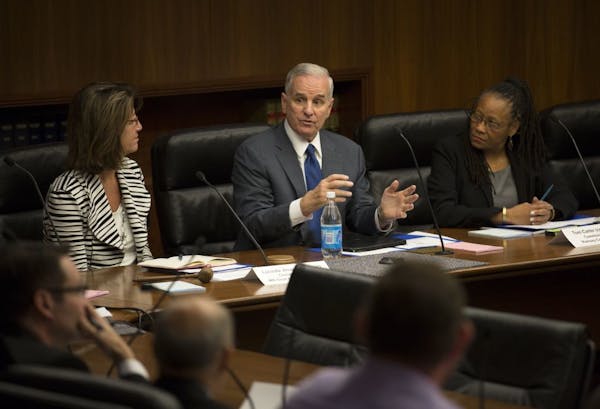Minnesota's move toward more aggressive investigation of child-abuse reports will mean more cases and more caseworkers — and more money to pay for them.
"We definitely feel more funding is due," Hennepin County Commissioner Marion Greene said of looming changes in the state's child-protection system.
The question for her and fellow County Board members is how much taxpayers in the state's largest county — its largest provider of child-protection services — will be asked to help with the bill.
In March, a state task force endorsed more than 100 changes to Minnesota's child-protection system. The Legislature aims to enact about 40 of them this session, with the expectation of more to come.
"Clearly, the recommendations are going to call for … more detailed investigations, and that's going to take people, and that's going to cost money," Commissioner Mike Opat said. "This is the hardest thing our staff and government does — determining whether a child is safe with his or her family."
All 87 counties will feel the changes. The Minnesota Association of County Social Service Administrators "conservatively" estimates the cost for the first wave of changes at $35 million statewide, according to executive director Eric Ratzmann. Bills under consideration in the Legislature would cover about $22 million for staffing and another $3 million for services statewide, leaving a gap of $10 million to be covered by counties.
In Hennepin County, the cost to ramp up for the first round of recommendations is estimated at $14.5 million, the equivalent of a 2 percent increase in county property-tax collections. That's the same as the county's overall increase from 2014 to 2015 for all uses.
Hennepin County, centered in Minneapolis, handles the state's largest load of cases. In 2014, of 73,600 child-protection reports, 15,500 were in Hennepin County.
Compounding the county's concerns about costs is the decadelong cinching of state funding it has already experienced via what Greene calls "a gradual starvation of the system."
Rex Holzemer, Hennepin County's assistant county administrator for human services, said the county funded 39 percent of children's services in 2003. By 2014, county property taxpayers were covering 50 percent of that bill. The state "shifted responsibility and costs to the counties," he said.
A worthy goal, with costs
Cost concerns aside, no one disagrees with the goal of doing a better job of protecting children. The counties had seats on the task force that made the recommendations for changes.
Gov. Mark Dayton created the task force last September after the Star Tribune reported child-protection failures that included the Pope County case of 4-year-old Eric Dean. Fifteen incidents of suspected maltreatment of the boy were reported, but Pope County investigators looked into only one before the boy was killed by his stepmother in 2013.
A key recommendation from the task force is to do away with a family assessment track for high-risk abuse cases. Instead, social workers would do deeper investigations, determining who was responsible and whether the child was abused.
To handle the additional investigations, Hennepin County estimates a need to add 117 more full-time child-protection employees to the existing staff of 160, Holzemer said. The cost would be $14.5 million. And that's just the first round of recommended changes.
Another significant recommendation for the coming years is for caseworkers to carry no more than 10 cases at a time, or eight for new hires. Holzemer said county workers now handle 20 to 22 cases apiece. "We're not trying to sound the alarm bell; we're just hopefully trying to be as realistic as possible," he said.
Ratzmann and Holzemer point out that the cost estimates account primarily for caseworkers, not the effects on other agencies. For example, more child-protection cases will require more police work and potentially more court cases requiring additional prosecutors and public defenders. "It has ripple effects throughout the system," Holzemer said. "That hasn't been factored in."
How much is enough?
Despite the tidal shift proposed for the system and the horrific stories that have inspired it, Minnesota remains below the national average in child fatalities, with a rate of .78 per 100,000 children, compared with an average of 2.2 per 100,000 children nationwide.
Changes to the system won't come with spending or staffing flexibility.
"It's not like there's any way to streamline that," Opat said. "It's more people, more work, a higher level of attention paid to these cases."
Then there's the eventual question of how much will be enough. Greene said she believes it's too soon to say. "Right now my focus is: How can we keep pressure on the Legislature?" she said. "We really are looking at the state for more funding."
Rochelle Olson • 612-673-1747
Twitter: @rochelleolson

University of Minnesota police arrest 9 after pro-Palestinian encampment set up on campus
2 dead in Lino Lakes, no known threat to public, police say
Teen charged with murder in deadly St. Paul shooting last month

